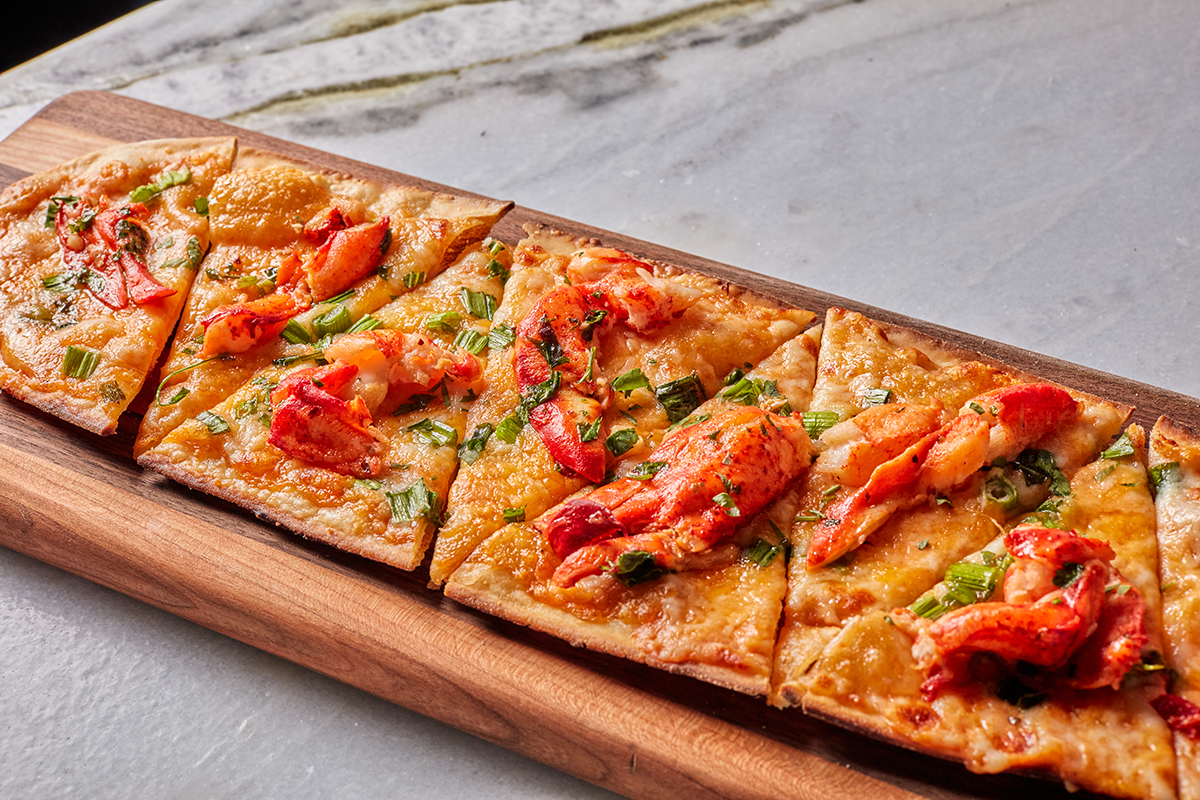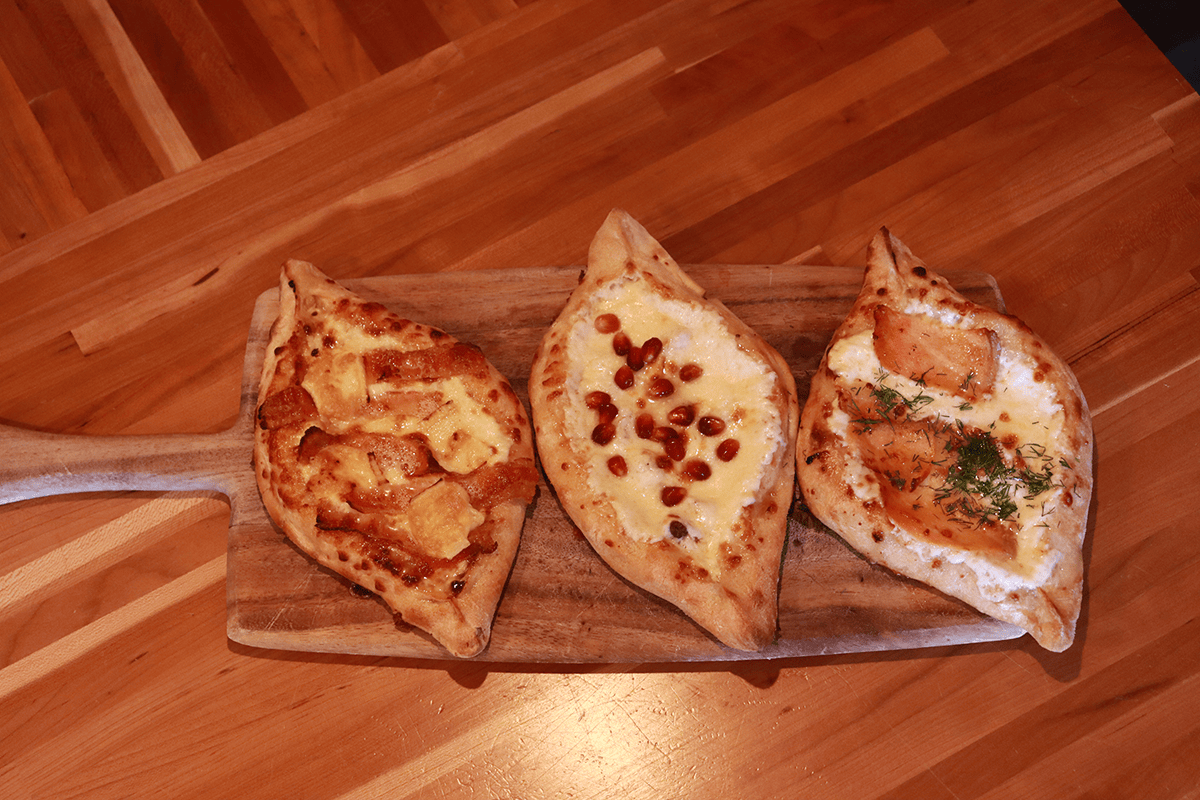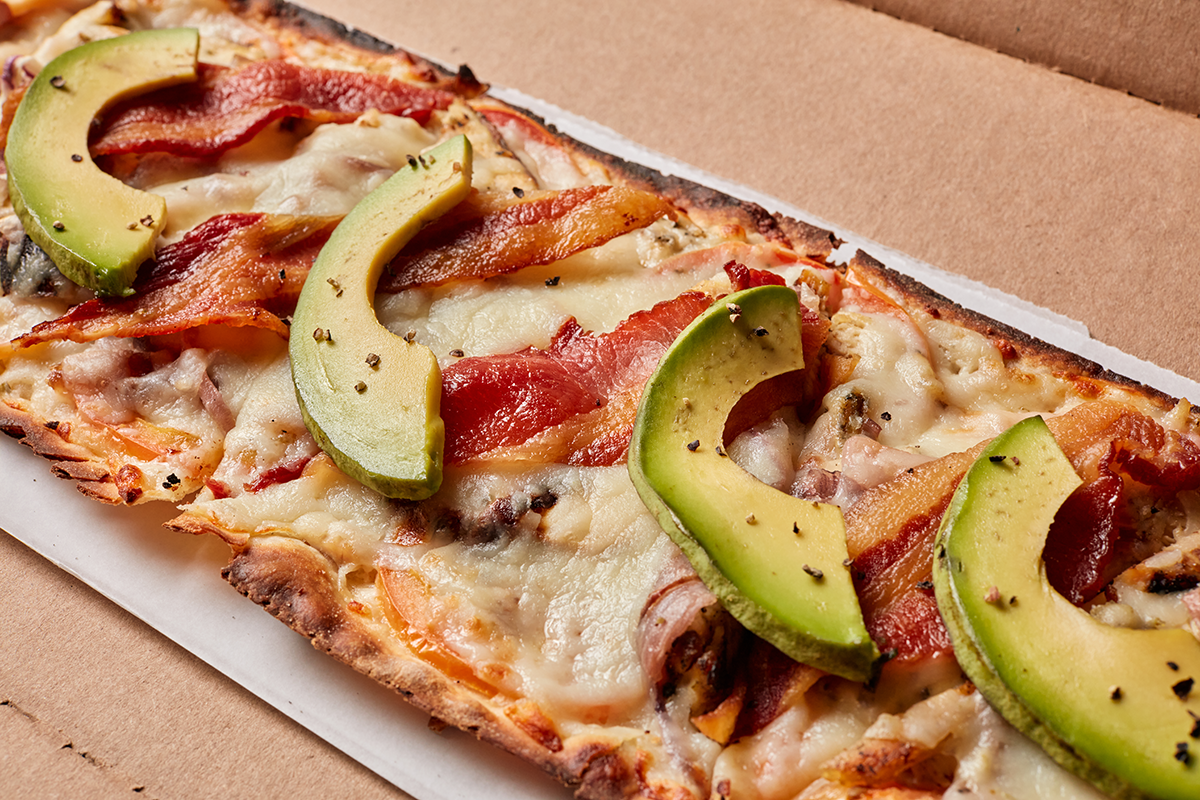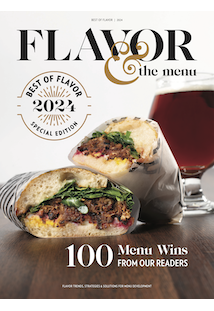
Flatbread for All
Introducing fresh flavors in a shareable format
Flatbread for All
Introducing fresh flavors in a shareable format
By Nicole Duncan
May 22, 2024
By Nicole Duncan
May 22, 2024
All too often, flatbread gets lumped in with pizza. And while the two dishes share a basic formula (dough base topped with a variety of ingredients), flatbread has roots in a number of global cuisines, lending it a more worldly pedigree than the typical pizza. Its smaller size and oblong shape often lands the dish on the appetizer or small plates section of the menu. And as guests gravitate toward more socially driven dining experiences, flatbreads offer a way to highlight a variety of inventive flavor combinations in a shareable, easy-to-eat format.
Global Roots, Mash-Up Potential
 Photo Credit: Keipi
Photo Credit: Keipi In addition to classic Georgian flatbread, Keipi offers nontraditional variations, including (left to right) bacon and brie with fig jam; meat and pomegranate; and salmon and dill.
Flatbread can be traced back to some of the earliest days of food preparation, when the only ingredients required were flour, a liquid (typically water or milk) and salt. Even now, many flatbreads remain unleavened. This simplicity gave rise to different iterations: roti and paratha in India, taftan in Persia, pide in Turkey, piadina in Italy and frybread in the Americas. Regions distinguished their own flatbreads by incorporating native herbs, spices, produce, cheeses and proteins. The innovation continues today with new cuisines and global mash-ups finding their way atop a flatbread.
In San Francisco, Guam-inspired Prubechu’ serves a coconut-infused flatbread (known as titiyas in Guam and the Mariana Islands) that showcases Chamorro flavors. It’s topped with Gulf shrimp kelaguen, which is marinated in lemon, coconut, hot pepper and scallions, much like a ceviche. At Beso Cocina, in San Luis Obispo, Calif., staple taco fillings like barbacoa, al pastor and conchita break out of the proverbial shell when tossed atop tlayuda, a Oaxacan tortilla that’s served like a flatbread. And just a few weeks ago, Roe Restaurant in London generated a mini uproar over its Snail Vindaloo Flatbread, which features the unlikely combination of bacon, curry and snails.
In Greenville, S.C., Keipi is introducing American palates to Georgian cuisine, with flatbread serving as a familiar bridge. In addition to staples like eggplant rolls with walnut paste, stuffed peppers and soup dumplings, the menu has a whole section dedicated to khachapuri, a cheese-filled flatbread. “Khachapuri is not a specific recipe; it is a large group of Georgian pies of varying degrees of complexity and richness,” says Irina Tarasenko, head chef and back-of-house lead for Keipi. “In each region of Georgia, khachapuri is cooked in a special way, and each family has its own traditions and preferences.”
The menu at Keipi includes the classic egg-topped Adjaruli khachapuri, as well as nontraditional variations, such as a bacon and brie with fig jam, salmon and dill, spicy veggie and even a vegan flatbread. Recognizable ingredients—plus a doughy base not so different from pizza—can coax skittish diners to try something new.
“As a restaurant in the Southeastern U.S., we believe a rigid approach to authenticity doesn’t work so well in offering a genuine first impression of a foreign cuisine to guests who may not be ready to try a combination of ingredients outside of their comfort zone,” says Michael Matthews, who works in Keipi’s front of house and serves as operations administrator. “It’s clear in Greenville that international fusion across cuisines improves offerings and brings in guests searching for something new. As a result, our kitchen has developed a delicious menu of specialty khachapuri with toppings that give respect to Georgia while paying tribute to local tastes.”
Breaking Flatbread Together
 Photo Credit: Your 3rd Spot
Photo Credit: Your 3rd Spot Recently, Your Third Spot reduced the portion sizes of its flatbreads, like the Smoked Pulled Chicken Flatbread, to encourage guests to share orders rather than treat the flatbreads as entrées.
Beyond the food itself, dishes like khachapuri create a more sociable atmosphere. After all, the earliest flatbreads emerged at a time when all meals were shared, and in many cultures, that emphasis remains. “The Georgian perspective is that dining should be a communal event when possible, and if you don’t have to eat alone, the best way to enjoy a meal is by ordering a few things to share with others,” Matthews says. This mindset hasn’t been the norm in the U.S., but the dining scene is evolving as menus featuring small plates and other shareable dishes become more common.
At the same time, the burgeoning “eatertainment” category is addressing consumer demand for experiential dining. With these hybrid concepts offering everything from bowling and bocce to pickle ball and mini golf, it goes to reason that a sociable atmosphere would beget a sociable menu of shareable bites designed for casual noshing.
“Our menu is only made up of shareable items and nothing with ‘sides.’ Very few items need a fork and knife,” says Josh Rossmeisl, founder and chief talent recruiter of Atlanta eatertainment brand Your 3rd Spot. “Flatbreads are craveable, shareable and memorable. It’s a perfect starter or a great late-night menu option that has mass appeal. When done right and with better ingredients, flatbread shines brightly on our menu.”
One fan favorite that’s been on the menu since opening is the Smoked Pulled Chicken Flatbread, featuring smoked-in-house chicken, red-chile barbecue, red onions, aged cheddar, mozzarella and chopped pickles. It’s topped with housemade Alabama white sauce and cilantro with ranch dressing on the side. Another standout is the Black Truffle Artichoke Bianca, with basil, ricotta, roasted garlic, spring onions and mozzarella.
Earlier this year, Your 3rd Spot made a significant change to its flatbreads, shrinking the 12-inch ovals down to rounded, mini 8-inch portions. The reason circles back to the communal dining element. “Our goal was to have a true ‘small plates menu’ that would encourage guests to try multiple items—two to three each is the goal,” Rossmeisl says. “The larger flatbreads were so popular that we noticed several guests just ordering this one item as their meal and not for the table. When we went smaller, it became less of a meal and more of a shareable snack.” He adds that flatbread sometimes carries a health halo that pizza does not. Your 3rd Spot also offers a larger and thicker Roni Sicilian Pizza Square, but flatbread sales are generally higher.
Balancing Familiar and Fresh
 Photo Credit: Pinstripes
Photo Credit: Pinstripes Pinstripes’ Chicken Avocado Club Flatbread deconstructs the popular sandwich and turns it into a shareable dish, making it a go-to for guests seeking something familiar—with a twist.
Fellow eatertainment brand Pinstripes, with 17 locations across the country, also serves a mix of flatbreads and pizzas. “Both our pizzas and flatbreads are great, sharable choices. The main distinction between the two is the amount of dough. Our pizzas are a hand-stretched Neapolitan style, with a thicker crust, whereas our flatbreads are stretched thin, creating a nice crispy texture and crunch,” says Cesar Gutierrez, chief culinary officer for Pinstripes. “Flatbreads often feature lighter, more diverse toppings, showcasing inventive ingredient combinations.”
This approach is well-exemplified by the Legendary Lobster Flatbread, which has been a top-seller since the brand introduced it last year. Housemade lobster bisque, cheddar, mozzarella and Parmesan are layered atop the dough base. Once baked, the flatbread is topped with buttery Maine lobster and fresh herbs. “This dish was inspired by creating a fun twist on a traditional lobster roll and reinventing it into a flatbread,” Gutierrez says. “The Legendary Lobster captivates with its decadent lobster-and-cheese combination, earning high praise for its indulgent taste.”
Equally popular is the Chicken Avocado Club Flatbread, which has been winning diners for more than a decade. Thinner than a pizza but thicker than deli bread, the dish is essentially a club sandwich converted into a flatbread, with pesto-marinated grilled chicken, crispy applewood-smoked bacon, roasted red onions, ranch dressing, fresh tomatoes, mozzarella cheese and avocado. Gutierrez describes it as a “go-to pick for guests looking for a familiar name with a twist.”
At the same time, he recognizes the potential of flatbread when it comes to introducing out-of-the-box ingredients. The dish’s recognizable format and shareable nature could push diners to try something new without the pressure of finishing an entire dish themselves. “Flatbreads provide a canvas for exploring unique flavor pairings, making them the perfect choice for our innovative dishes,” he says. “And the shareable nature of flatbreads enhances the communal dining experience, encouraging guests to connect and enjoy the meal together.”
All too often, flatbread gets lumped in with pizza. And while the two dishes share a basic formula (dough base topped with a variety of ingredients), flatbread has roots in a number of global cuisines, lending it a more worldly pedigree than the typical pizza. Its smaller size and oblong shape often lands the dish on the appetizer or small plates section of the menu. And as guests gravitate toward more socially driven dining experiences, flatbreads offer a way to highlight a variety of inventive flavor combinations in a shareable, easy-to-eat format.
Global Roots, Mash-Up Potential
 Photo Credit: Keipi
Photo Credit: Keipi In addition to classic Georgian flatbread, Keipi offers nontraditional variations, including (left to right) bacon and brie with fig jam; meat and pomegranate; and salmon and dill.
Flatbread can be traced back to some of the earliest days of food preparation, when the only ingredients required were flour, a liquid (typically water or milk) and salt. Even now, many flatbreads remain unleavened. This simplicity gave rise to different iterations: roti and paratha in India, taftan in Persia, pide in Turkey, piadina in Italy and frybread in the Americas. Regions distinguished their own flatbreads by incorporating native herbs, spices, produce, cheeses and proteins. The innovation continues today with new cuisines and global mash-ups finding their way atop a flatbread.
In San Francisco, Guam-inspired Prubechu’ serves a coconut-infused flatbread (known as titiyas in Guam and the Mariana Islands) that showcases Chamorro flavors. It’s topped with Gulf shrimp kelaguen, which is marinated in lemon, coconut, hot pepper and scallions, much like a ceviche. At Beso Cocina, in San Luis Obispo, Calif., staple taco fillings like barbacoa, al pastor and conchita break out of the proverbial shell when tossed atop tlayuda, a Oaxacan tortilla that’s served like a flatbread. And just a few weeks ago, Roe Restaurant in London generated a mini uproar over its Snail Vindaloo Flatbread, which features the unlikely combination of bacon, curry and snails.
In Greenville, S.C., Keipi is introducing American palates to Georgian cuisine, with flatbread serving as a familiar bridge. In addition to staples like eggplant rolls with walnut paste, stuffed peppers and soup dumplings, the menu has a whole section dedicated to khachapuri, a cheese-filled flatbread. “Khachapuri is not a specific recipe; it is a large group of Georgian pies of varying degrees of complexity and richness,” says Irina Tarasenko, head chef and back-of-house lead for Keipi. “In each region of Georgia, khachapuri is cooked in a special way, and each family has its own traditions and preferences.”
The menu at Keipi includes the classic egg-topped Adjaruli khachapuri, as well as nontraditional variations, such as a bacon and brie with fig jam, salmon and dill, spicy veggie and even a vegan flatbread. Recognizable ingredients—plus a doughy base not so different from pizza—can coax skittish diners to try something new.
“As a restaurant in the Southeastern U.S., we believe a rigid approach to authenticity doesn’t work so well in offering a genuine first impression of a foreign cuisine to guests who may not be ready to try a combination of ingredients outside of their comfort zone,” says Michael Matthews, who works in Keipi’s front of house and serves as operations administrator. “It’s clear in Greenville that international fusion across cuisines improves offerings and brings in guests searching for something new. As a result, our kitchen has developed a delicious menu of specialty khachapuri with toppings that give respect to Georgia while paying tribute to local tastes.”
Breaking Flatbread Together
 Photo Credit: Your 3rd Spot
Photo Credit: Your 3rd Spot Recently, Your Third Spot reduced the portion sizes of its flatbreads, like the Smoked Pulled Chicken Flatbread, to encourage guests to share orders rather than treat the flatbreads as entrées.
Beyond the food itself, dishes like khachapuri create a more sociable atmosphere. After all, the earliest flatbreads emerged at a time when all meals were shared, and in many cultures, that emphasis remains. “The Georgian perspective is that dining should be a communal event when possible, and if you don’t have to eat alone, the best way to enjoy a meal is by ordering a few things to share with others,” Matthews says. This mindset hasn’t been the norm in the U.S., but the dining scene is evolving as menus featuring small plates and other shareable dishes become more common.
At the same time, the burgeoning “eatertainment” category is addressing consumer demand for experiential dining. With these hybrid concepts offering everything from bowling and bocce to pickle ball and mini golf, it goes to reason that a sociable atmosphere would beget a sociable menu of shareable bites designed for casual noshing.
“Our menu is only made up of shareable items and nothing with ‘sides.’ Very few items need a fork and knife,” says Josh Rossmeisl, founder and chief talent recruiter of Atlanta eatertainment brand Your 3rd Spot. “Flatbreads are craveable, shareable and memorable. It’s a perfect starter or a great late-night menu option that has mass appeal. When done right and with better ingredients, flatbread shines brightly on our menu.”
One fan favorite that’s been on the menu since opening is the Smoked Pulled Chicken Flatbread, featuring smoked-in-house chicken, red-chile barbecue, red onions, aged cheddar, mozzarella and chopped pickles. It’s topped with housemade Alabama white sauce and cilantro with ranch dressing on the side. Another standout is the Black Truffle Artichoke Bianca, with basil, ricotta, roasted garlic, spring onions and mozzarella.
Earlier this year, Your 3rd Spot made a significant change to its flatbreads, shrinking the 12-inch ovals down to rounded, mini 8-inch portions. The reason circles back to the communal dining element. “Our goal was to have a true ‘small plates menu’ that would encourage guests to try multiple items—two to three each is the goal,” Rossmeisl says. “The larger flatbreads were so popular that we noticed several guests just ordering this one item as their meal and not for the table. When we went smaller, it became less of a meal and more of a shareable snack.” He adds that flatbread sometimes carries a health halo that pizza does not. Your 3rd Spot also offers a larger and thicker Roni Sicilian Pizza Square, but flatbread sales are generally higher.
Balancing Familiar and Fresh
 Photo Credit: Pinstripes
Photo Credit: Pinstripes Pinstripes’ Chicken Avocado Club Flatbread deconstructs the popular sandwich and turns it into a shareable dish, making it a go-to for guests seeking something familiar—with a twist.
Fellow eatertainment brand Pinstripes, with 17 locations across the country, also serves a mix of flatbreads and pizzas. “Both our pizzas and flatbreads are great, sharable choices. The main distinction between the two is the amount of dough. Our pizzas are a hand-stretched Neapolitan style, with a thicker crust, whereas our flatbreads are stretched thin, creating a nice crispy texture and crunch,” says Cesar Gutierrez, chief culinary officer for Pinstripes. “Flatbreads often feature lighter, more diverse toppings, showcasing inventive ingredient combinations.”
This approach is well-exemplified by the Legendary Lobster Flatbread, which has been a top-seller since the brand introduced it last year. Housemade lobster bisque, cheddar, mozzarella and Parmesan are layered atop the dough base. Once baked, the flatbread is topped with buttery Maine lobster and fresh herbs. “This dish was inspired by creating a fun twist on a traditional lobster roll and reinventing it into a flatbread,” Gutierrez says. “The Legendary Lobster captivates with its decadent lobster-and-cheese combination, earning high praise for its indulgent taste.”
Equally popular is the Chicken Avocado Club Flatbread, which has been winning diners for more than a decade. Thinner than a pizza but thicker than deli bread, the dish is essentially a club sandwich converted into a flatbread, with pesto-marinated grilled chicken, crispy applewood-smoked bacon, roasted red onions, ranch dressing, fresh tomatoes, mozzarella cheese and avocado. Gutierrez describes it as a “go-to pick for guests looking for a familiar name with a twist.”
At the same time, he recognizes the potential of flatbread when it comes to introducing out-of-the-box ingredients. The dish’s recognizable format and shareable nature could push diners to try something new without the pressure of finishing an entire dish themselves. “Flatbreads provide a canvas for exploring unique flavor pairings, making them the perfect choice for our innovative dishes,” he says. “And the shareable nature of flatbreads enhances the communal dining experience, encouraging guests to connect and enjoy the meal together.”
About the Author
![]() Nicole Duncan is the digital managing editor of Flavor & the Menu. She's reported on the restaurant industry for a decade, most recently as the editor of FSR magazine. In 2021, she won a Folio award for her feature on restaurant tycoon Tilman Ferttita. The following year, FSR was awarded Best Overall Issue for its May 2022 issue featuring Andrew Zimmern. She has profiled well-known chefs including Paola Velez, Fabio Viviani and Daniel Boulud, but also relishes the opportunity to spotlight under-the-radar trends and innovators.
Nicole Duncan is the digital managing editor of Flavor & the Menu. She's reported on the restaurant industry for a decade, most recently as the editor of FSR magazine. In 2021, she won a Folio award for her feature on restaurant tycoon Tilman Ferttita. The following year, FSR was awarded Best Overall Issue for its May 2022 issue featuring Andrew Zimmern. She has profiled well-known chefs including Paola Velez, Fabio Viviani and Daniel Boulud, but also relishes the opportunity to spotlight under-the-radar trends and innovators.







